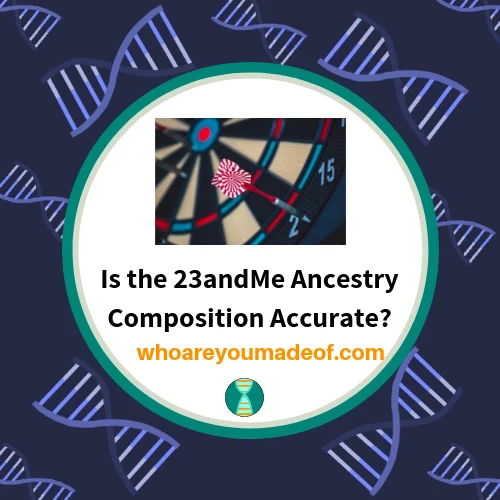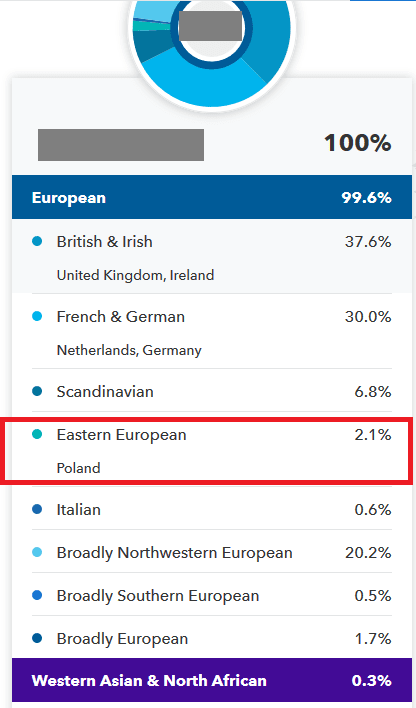In this post, I'll tell you everything that you need to know about how to understand the accuracy of 23andMe Ancestry Composition reports. Plus, you'll learn a little about how ethnicity or ancestry is inherited, and whether or not you can really expect your estimate to match your family tree.
If you wonder if the 23andMe Ancestry Composition results are accurate, you have come to the right place. The Ancestry Composition report is one of the most popular aspects of 23andMe results, and with good reason.

Who doesn't love the idea of being able to find out where their ancestors were born by doing a simple saliva DNA test?
How is ethnicity inherited?
In order to make an accurate judgement about the accuracy of any company's DNA results (especially ethnicity estimates), it's important to understand a few basic fundamentals about the way that DNA is passed down and how ethnicity is inherited.
Each person inherits 50% of their DNA from each of their parents. No one shares more than about 50% of their DNA with either of their parents. The DNA that we inherit from our parents contains ethnicity information that they inherited from their parents.
Some DNA information is lost to history
Important to note is that we don't inherit 100% of our parents' DNA. In other words, our mother doesn't pass down 50% of her DNA to use, and we also didn't inherit 50% of our father's DNA. This is so important to realize, and I believe that the source of the majority of confusion about ethnicity estimates.
So, when we are thinking about 23andMe results and their accuracy, we should keep this in mind as we compare our results to our family tree. (I hope that you have built one!)
Will ethnicity from all of my ancestors show up on my 23andMe Ancestry Composition report?
Because you didn't inherit 100% of your mom and dad's DNA, and they didn't inherit 100% of their parents' DNA, and your grandparents didn't inherit 100% of their parents' DNA, and your great-grandparents didn't inherit 100% of their parents' DNA, you didn't inherit any ethnicity information from many of your ancestors.
Our 23andMe Ancestry Composition estimates can only show results for DNA that we did inherit, and can't tell us anything about DNA that didn't get passed down to us.
We inherited at least some DNA from all of our recent ancestors
With that said, you did inherit substantial DNA from all of your recent ancestors (as far back as great-great-great-great grandparents), and so our 23andMe DNA results can provide incredible insight into where our ancestors lived going back for hundreds of years.
For example, my father's 4th great-grandparents were born in the late 1700s. Considering that the DNA that my dad inherited from his 4th great-grandparents consisted of DNA that those ancestors inherited from their distant ancestors, my dad's DNA results can reach quite far back into history.
Pro tip: Have as many family members do DNA tests as possible. Siblings don't inherit the same 50% of DNA from their parents, so they could show ethnicity/ancestry information that didn't show up for the other siblings. Testing parent, aunts, uncles, and grandparents is a fantastic way to get a more complete picture of the family's recent ancestry.
How accurate is the 23andMe Ancestry Composition estimate?
I've been working on my family tree for several years and have done DNA tests with all of the major companies. In my experience, the 23andMe Ancestry Composition report is very accurate. I have been very happy with the results from both of my parents, and I've been able to learn a lot of new information about my roots.
I was SO surprised that 23andMe was able to provide such specific detail in my parents' results.
In fact, 23andMe was able to detect my dad's recently-discovered Polish ancestry. On other sites, his Polish roots simply showed up as "Eastern Europe" - it was never more specific. 23andMe detected Eastern Europe, but was able to provide the more specific Poland region (and the specific counties within Poland!).

Adjust the confidence levels of your Ancestry Composition estimate for more accuracy
A really cool feature of 23andMe results is the ability to adjust the confidence level of your Ancestry Composition estimate. There is a level of uncertainty that comes with any ethnicity estimate, and I think it's neat that 23andMe allows you to play around with adjusting the confidence in order to see which regions show up at different confidence levels.
My mom had 2.3% Ashkenazi Jewish show up on her 23andMe results, which didn't surprise me (she had it show up on Ancestry and My Heritage, too). Out of curiosity, I adjusted the confidence level from the default 50% (speculative) to 90% (conservative) - just to see what would happen:

By adjusting the confidence level, I saw that my mom's Ashkenazi Jewish never disappeared, even at the highest level of confidence. That sure increased MY confidence level that if I look hard enough in her tree, I'll find her European Jewish ancestors.
So, will the 23andMe Ancestry Composition match my family tree?
Your 23andMe results should match your recent known family tree - to an extent, and with an important caveat. The 50% of our parents' DNA that we inherited was "randomly selected" by nature, so we don't always inherit our ancestor's ethnicity regions in even halves. For this reason, it's possible for our grandmother to have been 25% Nigerian and to have only inherited 12% of this region from her, for example.
What's the caveat? Even if we know where our ancestors were born, we don't really, truly know what their DNA results would have looked like. That is to say that we don't really know if our Italian ancestors would have appeared as 100% Italian on a DNA test. Maybe they had Eastern European roots, or Sephardic Jewish ancestry, or had family who had recently migrated to Italy from France.
Most of our ancestors likely had a mix of ancestry, just like we do today. They most likely would have had at least some heritage in neighboring geographic areas. For example, someone from Poland might have had Danish, German, or Russian heritage.
Have you done a 23andMe test yet?
If you are reading this post because you wanted to know what to expect from your test results, and you have decided that you want to go ahead and get your 23andMe ancestry test, you can get your test by clicking on the following links.
I will get a very small commission at no extra cost to you if you click the links below, and it helps me support the writing that I do on this website - thank you so much
- To get the 23andMe ancestry only test: Make new family connections and discover your DNA story together. Order your DNA test kit today at 23andme.com.
- If you want to get the 23andMe ancestry + health test, you can use this link to get $10 off your test: Get 10% off each additional Health + Ancestry Service from 23andMe.
Conclusion
I hope that this post has helped you get a good as idea about the accuracy of 23andMe results. DNA testing is a really cool experience, and I hope that you learned something in this post that inspired you to do a test or learn more about your results.
If you have questions about something that you read in this post or if you would like to share your own experience with 23andMe Ancestry Composition reports, please feel free to join us in the discussion below.
Thanks for being here on the site today 🙂

